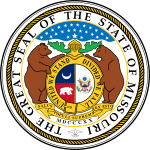| |||||||||||||||||||||||||||||
| |||||||||||||||||||||||||||||
 County Results
| |||||||||||||||||||||||||||||
| |||||||||||||||||||||||||||||
| Elections in Missouri |
|---|
 |
The 1896 United States presidential election in Missouri took place on November 3, 1896. All contemporary 45 states were part of the 1896 United States presidential election. Voters chose 17 electors to the Electoral College, which selected the president and vice president.
Missouri was won by the Democratic nominees, former U.S. Representative William Jennings Bryan of Nebraska and his running mate Arthur Sewall of Maine. Four electors cast their vice presidential ballots for Thomas E. Watson. Unlike in the more easterly border states, Bryan's "free silver" platform had very substantial appeal in the Unionist but highly populist Ozark "Bible Belt".[1] This was seen in that Missouri had in Richard P. Bland that earliest advocate of that monetary policy in Congress,[2] and that only one vote had been cast in 1893 in Missouri against free silver, and that in St. Louis.[3] Although all but one of Missouri's pro-silver members had reversed course by the time of the presidential election, the state was still hit much more than the Old Northwest and upper Mississippi Valley by farmers' debts from falling prices and crop failures since 1887.[4] Despite opposition by the St. Louis Globe-Democrat to Bryan's free silver policies,[4] Bryan gained strongly via capture of James B. Weaver's support base from the 1892 and 1880 elections in the strongly Baptist southwest, which was enough to counter Catholic defections from Grover Cleveland in St. Louis and surrounds.[5] Bryan won Missouri by a margin of 8.71%.
This is the only election since the Civil War where Douglas County voted for a Democratic presidential candidate.[6] Bryan was also the first Democrat since James Buchanan in 1856 to carry Dade, Dallas, Jasper, Lawrence, Polk and Wright Counties.[5]
Bryan would win Missouri again against McKinley four years later but would later lose the state in 1908 to William Howard Taft.
- ^ Hoffmann, Charles; 'The Depression of the Nineties'; Journal of Economic History (1956); vol. 16, no. 2, pp. 137-164
- ^ Clevenger, Homer; 'Missouri Becomes a Doubtful State'; The Mississippi Valley Historical Review, vol. 29, no. 4 (March 1943), pp. 541-556
- ^ Haynes, Frederick Emory; 'The New Sectionalism'; The Quarterly Journal of Economics, vol. 10, no. 3 (April 1896), pp. 269-295
- ^ a b Fite, Gilbert C.; 'Republican Strategy and the Farm Vote in the Presidential Campaign of 1896'; The American Historical Review, vol. 65, no. 4 (July 1960), pp. 787-806
- ^ a b Menendez, Albert J.; The Geography of Presidential Elections in the United States, 1868-2004, p. 31 ISBN 0786422173
- ^ Menendez; The Geography of Presidential Elections in the United States, pp. 239-246
© MMXXIII Rich X Search. We shall prevail. All rights reserved. Rich X Search


